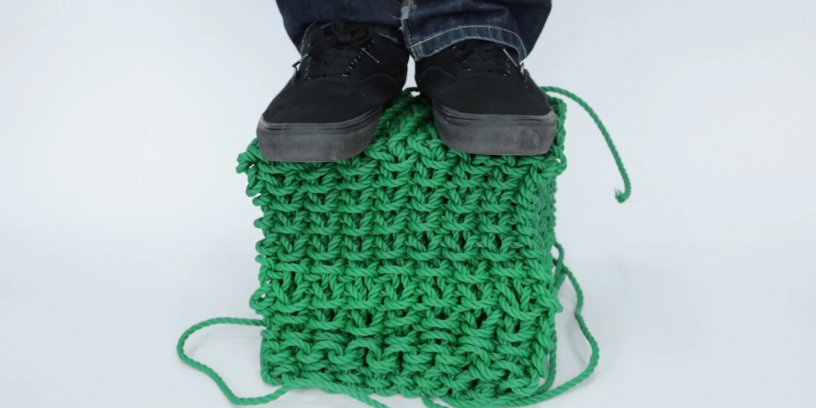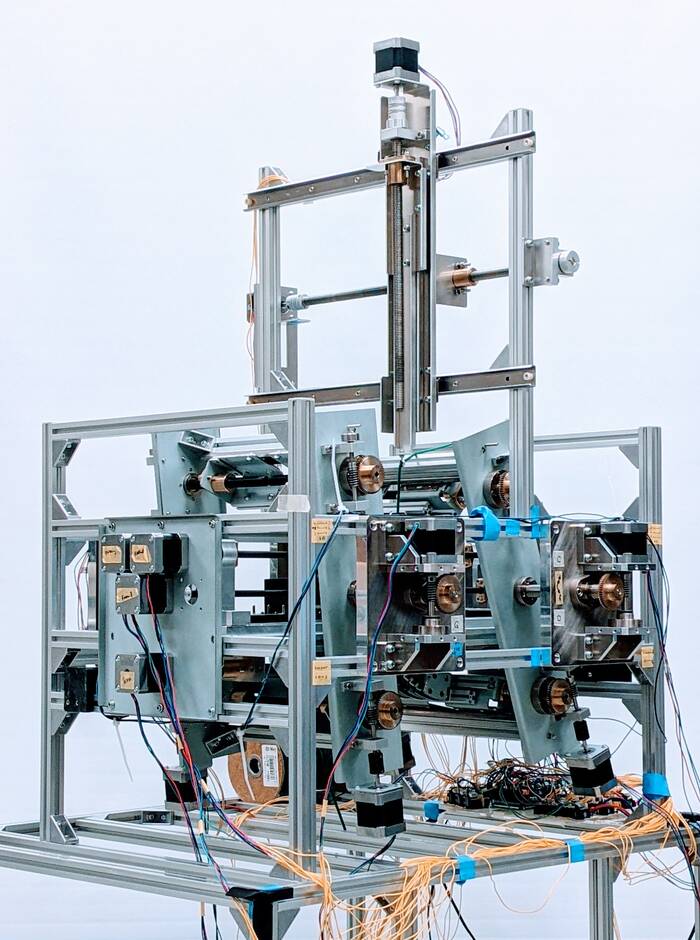UK company develops new 3D knitted carbon fibre preforms
Flat Knitting
Solid Knitting – a new fabrication technique
Researchers at Carnegie Mellon University’s School of Computer Science build revolutionary machine that can knit solid objects.

5th August 2024
Knitting Industry
|
Pittsburgh, PA, USA
Yuichi Hirose has a dream - a dream that someday everyone will have access to a machine capable of knitting furniture. This machine wouldn’t just knit the furniture’s exterior fabric, but would use knitting to fashion solid three-dimensional chairs, tables and other objects. Tired of that love seat? Just unravel it and reuse the yarn to knit yourself an ottoman.
This new fabrication technique - first envisioned by Hirose, a robotics Ph.D. student in Carnegie Mellon University’s School of Computer Science - is called solid knitting. The idea captured his imagination more than a decade ago, and now, working with a research team headed by James McCann, an associate professor in the Robotics Institute, he's made it a reality.
“My dream is to have these solid knitting machines everywhere in the world,” Hirose said.

According to the researchers, solid knitting can be thought of as similar to 3D printing. Just as 3D printers build shapes layer by layer, solid knitting builds shapes by adding knitted layer after knitted layer. But rather than being held together by glue or melted plastic, each new layer is stitched to the previous one.
It is possible to produce solid knitting by hand, rather than with a machine, to gain a deeper understanding, and the researchers have released a set of hand knitting instructions and a video for knitters who'd like to know more.
“It can be hard to wrap your head around the concept,” said McCann, leader of the Carnegie Mellon Textiles Lab. “But it’s a very cool idea, and one that has a lot of promise.”

Hirose got the idea back in 2012, while he was working on his master’s degree in digital fabrication at Keio University in Japan. He was interested in reconfigurable objects, spurred in part by a project in SCS’s Computer Science Department called Claytronics. That project sought to build small modular robots that self-assembled to create many different shapes.
“Those robots were very cool, but not very versatile,” he said.
The modular robots generally were connected to each other by means such as magnets or friction (similar to LEGO bricks) and could be easily dislodged. Hirose was looking for something more durable, but still reconfigurable. That’s when he got the idea for solid knitting.
He finished his master’s and headed out into the working world, but he never gave up the solid knitting idea. Eventually, he secured some grants, quit his job and, in 2018, began building a solid knitting machine. Like commercial knitting machines, his used rows of latch needles - hooked needles with latches that can be closed or opened - to manipulate yarn and hold loops open for the next stitching row.

While he was still building the machine, Hirose saw a report on the internet about a software project by McCann that made it easier to reprogram commercial knitting machines. This method provided a practical way to use the machines to make customised 3D knitted pieces. These were hollow shapes, such as bunny rabbits that could be stuffed, not solid knitted pieces, but Hirose and McCann began talking about a possible collaboration.
Hirose’s knitting machine was somewhat finished by 2020, but the pandemic put the collaboration on hold. In 2021, Hirose finally joined the Textiles Lab as a research assistant and, later, joined the Ph.D. program in robotics.
The CMU team presented its solid knitting research and the prototype machine at SIGGRAPH 2024, the annual Conference on Computer Graphics and Interactive Techniques, where it won an honourable mention in the Best Paper competition. SIGGRAPH posted a blog entry about the project.
The prototype, about the size of a clothes dryer, is still limited in the shapes and sizes it can produce. It can make triangular or rectangular prisms of varying lengths. The goal is to create a machine that can produce solid objects automatically, but more work is necessary to improve its operation.
The machine stretches the yarn loops quite a bit, so the researchers have used elastic cord as their yarn. Yet the resulting solid knits are “surprisingly firm, considering that they are made of floppy cord,” McCann said.
“It feels sort of like a stack of felt or the sole of a shoe,” he said.
Though the machine is now limited in what it can produce, it is possible to use the technique to hand-knit larger, more intricate shapes, such as a pair of sandals.
Hirose said he plans to take future research in two different directions: building a much bigger machine for producing furniture and making a smaller machine for precise objects.
“We hope that other people out there are going to build their own solid knitting machines and come up with ideas we haven’t yet explored,” McCann said.
This amazing Solid Knitting video explains the solid knitting technique really clearly and shows how the knitting machine works in principle...
In addition to Hirose and McCann, the research team included Angelica Bonilla Fominaya, a former arts and computer science student now a Google software engineer, who used the technique to produce art pieces. Mark Gillespie, who recently received his Ph.D. in computer science, developed the project’s 3D visualisation software, which has proven a boon in understanding the complex design process.
The research was supported by Japan’s Ministry of Internal Affairs and Communications, Panasonic Holdings Corp., Japan’s Information-Technology Promotion Agency, and the National Science Foundation.
More information is available on the project website, particularly for other researchers.

Business intelligence for the fibre, textiles and apparel industries: technologies, innovations, markets, investments, trade policy, sourcing, strategy...
Find out more












